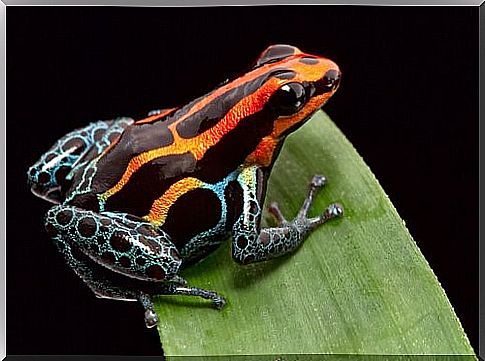What Is Aposematism?

A defense mechanism of insects, reptiles and amphibians with which they signal danger to their enemies is called aposematism or warning color.
So aposematism means that animals use flashy patterns and colors to protect themselves. Because shrill colors signal danger and deadly poison.
Another type of aposematism shows itself through noises, for example the acoustic warning of rattlesnakes.
The term is made up of two Greek words: “apo” (distant, far away) and “sema” (sign). It’s about keeping predators away.
How does aposematism work in animals?
Animal aposematism is almost always defensive. However, potential predators must have had an unpleasant experience with the warning colors or patterns at least once in order to associate them with danger.
Aposematism is an extremely powerful defense mechanism because no further actions or strategies are required. In this way, animals keep their enemies away without having to expend energy.
However, there are also animals that are not poisonous or dangerous at all, but imitate the appearance of the dangerous species in order to benefit from this protective mechanism.
This phenomenon is called Betesian mimicry after its discoverer. In reality, the animals are harmless, but this also keeps their enemies away.
A good example of this are the fake coral snakes, which are the same colors as the real ones but in a different order.
Various plants also use the strategy of aposematism. But this phenomenon occurs less frequently in the plant world.
Some plants indicate with bright colors, bad taste or thorns that it is better to stay away.
Aposematism in the animal kingdom
The most common and well-known animals that use this strategy are wasps and bees. They show a pattern of yellow and black rings that are clearly visible.
They tell all animals that they have a poisonous sting that they do not hesitate to use when they are in danger or when their stick is attacked.
Caterpillars also use their color to prevent them from being eaten by natural predators. Because of this, caterpillars come in a wide variety of colors and shapes.
They warn of toxins that they themselves use to digest certain plants.
Poison dart frogs or poison dart frogs (Dendrobatidae) are other examples of animals with aposematism.
They too, with their bright colors, warn of toxins that are present in their skin. This species of frog is native to Central and South America.
Coral snakes also benefit from their warning colors. They are extremely poisonous. The most famous ones have red, black, and white rings. They inhabit tropical regions in America (73 species), Africa and Asia (16 species).
The aerial lionfish (Pterois antennata), which lives in the Indian Ocean as well as the Pacific Ocean, is an animal with aposematism due to its striking red and white stripes and its strange and threatening appearance.
The spines protruding from its dorsal fins have poisonous glands that contain a potent venom that can seriously affect large mammals.









